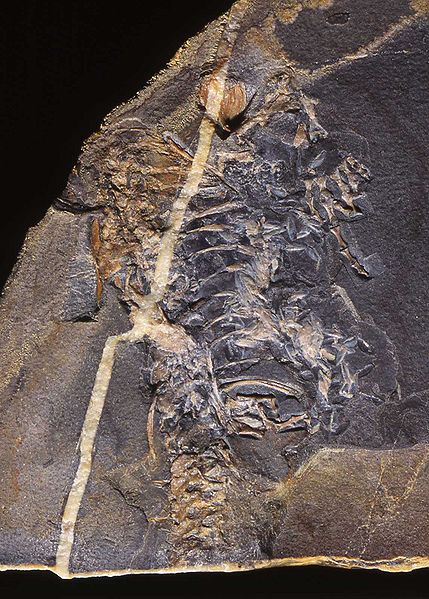 |
 |
 |
 |
 |
Produced
by the Population Genetics and Evolution class, Furman University |
||||
 |
 |
 |
 |
 |
Produced
by the Population Genetics and Evolution class, Furman University |
||||
 |
The
Carboniferous: Casineria |
 |
||
| Casineria
was a tetrapod that lived during the Mississippian portion of the Carboniferous
Period (Wikipedia 2009). The first specimen was found on the shores of
Cheese Bay, Scotland in 1992 and was formally presented in Nature
magazine in 1999 (Wikipedia 2009). This small reptilomorph was about 15
centimeters, and along with other similar species, was the first vertebrate
to live and reproduce on land (Wikipedia 2009). This ability was made
possible by having a stiff backbone, five digits on each hand, more advanced
leg bones that could support its slender body while walking on land, and
the ability to lay eggs outside of water - thereby skipping the aquatic
larval stage of amphibians (Monastersky 1999). These 'amniotic' eggs had
multiple embryonic membranes that surrounded, protected, and nourished
the growing fetus. However; the outer shell was not hard like present
day reptiles (Fossil Wiki 2010). These multiple membranes allowed for
gases, nutrients, and waste to pass through with out loosing water, and
are not present in the simpler eggs of fish and amphibians (Monastersky
1999). Since the multiple membranes kept the egg moist and prevented it
from drying out, primitive amniotes like Casineria were able
to spread out and colonize land (Wikipedia 2010). From Casineria
and its terrestrial adapted, egg-laying descendents, present day reptiles,
birds, and mammals evolved (Fossil Wiki 2010). Page by Chapin Hardy |
 |
| Casineria. Photo Credit: Wikipedia | |
|
Fossil Wiki. 2010. Amniote. Accessed March 3, 2010. Monasterky R. 1999. Out of the Swamp. Science News Online. Accessed March 3, 2010. Wikipedia.2010. Amniote. Accessed March 3, 2010. Wikipedia.2010.
Casineria. Accessed March 3, 2010 |